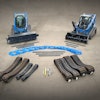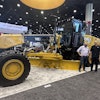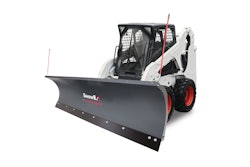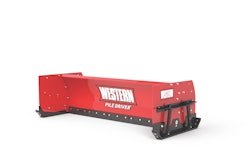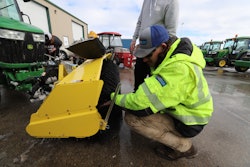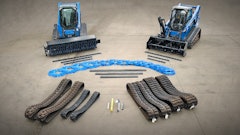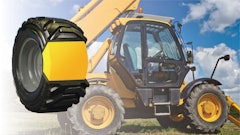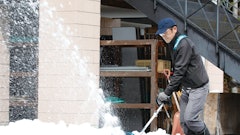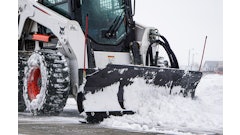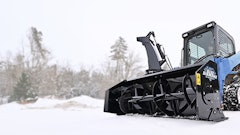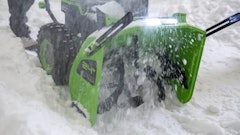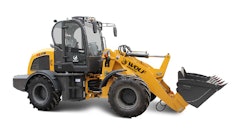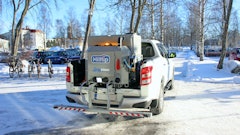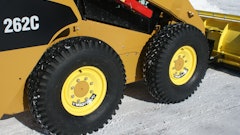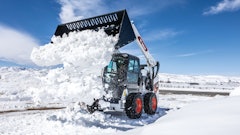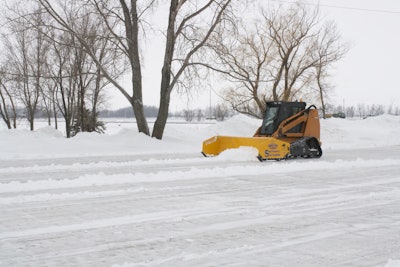
By Randy Strait
To get the most out of seasonal services, construction contractors need to consider their equipment’s efficiency and ability to accurately and precisely clear their customer’s properties in as few passes as possible. Balancing liability exposure and productivity may seem like a tightrope to walk, but if snow removal contractors incorporate these strategies and look for the right pusher features, they will be successful.
1. Size it right and calculate pushing time
A customer’s property size helps contractors determine the type and amount of equipment they should use. To start with, pick a pusher with the proper size and weight for the skid steer or loader as well as for the application. Bigger pushers aren’t always better.
For example, a skid steer equipped with a 10-foot pusher ideally clears narrow parking aisles and handicapped parking spaces during the day with traffic present — a common occurrence when people scramble for supplies to ride out the storm. A 19-foot loader-mounted pusher works more efficiently on large lots with wider clearing areas.
Many contractors with containment plows use a formula based on acres and pushing capacity to determine productivity ahead of time. This creates a strategy for operator schedules and determines priority when it comes to clearing properties according to size.
For example, if there is 3-inches of snow on the lot a 10-foot containment plow with a pushing capacity of 13 yards will take roughly 30 minutes to clear anywhere from two to three acres. A contractor using a 16-foot model with a 28-yard capacity can estimate the same job in the same weather conditions to take about half the time. This formula changes depending on snow conditions and characteristics, such as wet snow, which takes longer to clean, but it gives a rough timeframe with which to work and helps determine the amount of pushers and machines needed.
2. Cut salt
A pusher with features that successfully remove ice cuts out the need to spend time applying salt. A sectional snow pusher with a steel cutting edge effectively scrapes even hard-packed snow and ice down to the pavement on the first pass. Plus, the individual sections of the pusher get into dips and depressions in the pavement — leaving cleaner results by removing more snow and ice with each pass than traditional designs. This saves time and cuts significant outsourcing costs, such as hiring extra pick-up plow operators for follow-up snow removal. It also reduces the amount of salt needed.
3. Move easily
A drop-and-go slip-style hitch lets the pusher move freely from the equipment and automatically adjust to any change in pavement. This prevents the operator from having to manually correct the pusher each time it drops, which needs to be done with other hitch styles. This leads to a time-consuming, challenging and — for inexperienced operators — frustrating process that if done incorrectly results in extra maintenance and repairs.
A hitch that lets the pusher lie properly each and every time extends the pusher’s life and guarantees a clean surface. Plus, a pusher that keeps the carrier equipment moving rather than creating drag also conserves salt and fuel.
4. Get easy maintenance
Quick and easy serviceability in the field minimizes downtime and increases efficiency. It’s beneficial for an operator to have parts readily available in order to fix damaged components. Doing so cuts repair time quickly, down to only about 10 to 15 minutes. This gets contractors back to work faster rather than waiting for a shop mechanic to repair the pusher.
5. Reduce operator fatigue
An efficient pusher helps operators avoid long hours and fatigue that lead to costly mistakes and carelessness. This affects a contractor’s safety and could damage the customer’s property or lead to an accident. Stay safe and efficient with the right strategy and pusher this season.
During 40 years in the snow removal business, Randy Strait, owner and president of Arctic Snow & Ice Control Inc. and Arctic Snow & Ice Products, has tackled everything from his own driveway to parking lots at some of the nation’s largest businesses. He believes the key to quality work and reduced liability is to be prepared for each and every snow removal job — no matter the size.
